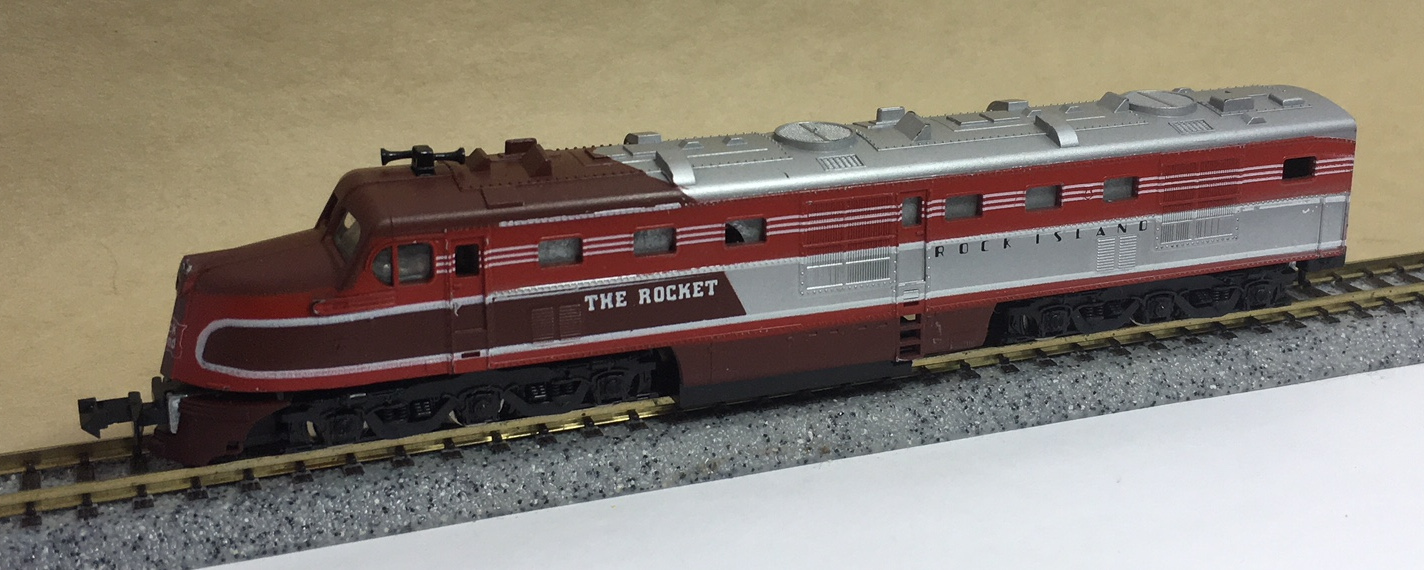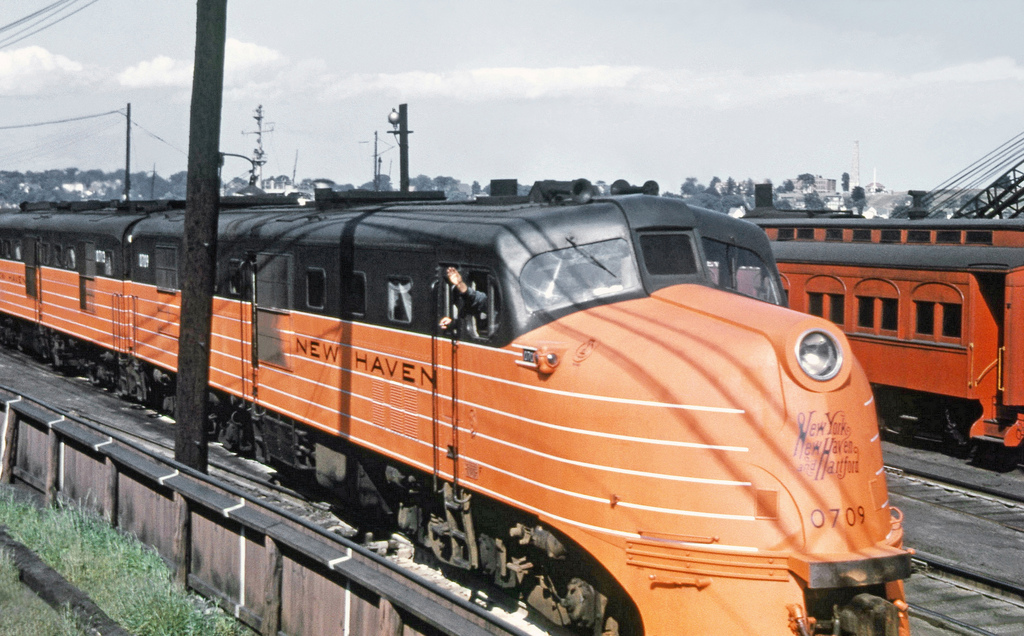Specific Item Information: Unpowered dummy engine.
Rock Island purchased two DL-107 (#621, #623), one DL-105 (#622) and one DL-103 (#624).
Road number unknown, can be either #621, #622 or #623.
Rock Island purchased two DL-107 (#621, #623), one DL-105 (#622) and one DL-103 (#624).
Road number unknown, can be either #621, #622 or #623.
Model Information: Con-Cor first released this Kato-manufactured model in 1982. In 1995, Con-Cor produced a second release, this time manufactured in China. Unlike many Chinese retoolings, this one is essentially a 'clone' of the Japanese version and if you lift off the shell you will see the mechanisms of the two are pretty similar. To determine which version you have, just check the bottom of the fuel tank (where it will say either "Made in China" or "Made in Japan").
Both mechanisms use and older design, but it works reasonably well. The motor is a 5-poler hidden inside a block of metal. The chassis consists of three pieces: one upper half and two lower halve.. All twelve wheels provide pickup and there are no traction tires, with current flowing directly from the metal truck assemblies into the electrically isolated lower frame halves without the use of wires. Apart from the metal worm gears, all the rest of the gearing is plastic. Eight of the twelve wheels are geared. Couplers are truck-mounted Rapidos. A directional headlight is wired to the front of the chassis.
As there are only negligible visual differences between DL-105, DL-107 and DL-109, Con-Cor produced only one model as DL-109 to stand in for all three types. The DL-109 was the by far the largest run of the series with a total of 62 built. Unpowered dummy "A" units with directional lighting were also available for all released road names, although no "B" (DL-110) units.
Both mechanisms use and older design, but it works reasonably well. The motor is a 5-poler hidden inside a block of metal. The chassis consists of three pieces: one upper half and two lower halve.. All twelve wheels provide pickup and there are no traction tires, with current flowing directly from the metal truck assemblies into the electrically isolated lower frame halves without the use of wires. Apart from the metal worm gears, all the rest of the gearing is plastic. Eight of the twelve wheels are geared. Couplers are truck-mounted Rapidos. A directional headlight is wired to the front of the chassis.
As there are only negligible visual differences between DL-105, DL-107 and DL-109, Con-Cor produced only one model as DL-109 to stand in for all three types. The DL-109 was the by far the largest run of the series with a total of 62 built. Unpowered dummy "A" units with directional lighting were also available for all released road names, although no "B" (DL-110) units.
DCC Information: No provision for DCC in either release.
Prototype History: The ALCO DL-109 is one of six models of A1A-A1A Diesel locomotives built to haul passenger trains by the American Locomotive Company (ALCO) between December, 1939 and April, 1945 ("DL" stands for Diesel Locomotive). They were of a cab unit design, and both cab-equipped lead A units DL-103b, DL-105, DL-107, DL-109 and cabless booster B units DL-108, DL-110 models were built. The units were styled by noted industrial designer Otto Kuhler, who incorporated into his characteristic cab (US Patent D121,219) the trademark three-piece windshield design. A total of 74 cab units and four cabless booster units were built.
Alco's DL-109 marks their early entry into the passenger diesel market in 1940. With its sleek lines, knife-edged nose and long wheelbase, it was ideally suited for high-speed service, and with 2,000 horsepower under the hood, it could handle passengers or high-speed freight with ease. Because of its dual-service capabilities, Alco was allowed to construct the DL-109 in the face of wartime restrictions on passenger-only locos, and the units performed admirably round the clock, handling passengers during the day and freight trains at night. Using lessons learned with the DL-109, it was succeeded by the PA-1 in 1946. Full data sheet on The Diesel Workshop.
Read more on Wikipedia.
Alco's DL-109 marks their early entry into the passenger diesel market in 1940. With its sleek lines, knife-edged nose and long wheelbase, it was ideally suited for high-speed service, and with 2,000 horsepower under the hood, it could handle passengers or high-speed freight with ease. Because of its dual-service capabilities, Alco was allowed to construct the DL-109 in the face of wartime restrictions on passenger-only locos, and the units performed admirably round the clock, handling passengers during the day and freight trains at night. Using lessons learned with the DL-109, it was succeeded by the PA-1 in 1946. Full data sheet on The Diesel Workshop.
Read more on Wikipedia.
Road Name History: The Chicago, Rock Island and Pacific Railroad (CRI&P RR) (reporting marks RI, ROCK) was a Class I railroad in the United States. It was better known as the Rock Island Line, or, in its final years, The Rock. At the end of 1970 it operated 7183 miles of road on 10669 miles of track; that year it reported 20557 million ton-miles of revenue freight and 118 million passenger-miles. (Those totals may or may not include the former Burlington-Rock Island Railroad.)
Its predecessor, the Rock Island and La Salle Railroad Company, was incorporated in Illinois on February 27, 1847, and an amended charter was approved on February 7, 1851, as the Chicago and Rock Island Railroad. Construction began October 1, 1851, in Chicago, and the first train was operated on October 10, 1852, between Chicago and Joliet. Construction continued on through La Salle, and Rock Island was reached on February 22, 1854, becoming the first railroad to connect Chicago with the Mississippi River.
In 1980 Rock Island was liquidated. The railroad's locomotives, rail cars, equipment, tracks, and real estate were sold to other railroads or to scrappers. William Gibbons (the trustee) was able to raise more than $500 million in the liquidation, paying off all the railroad's creditors, bondholders and all other debts in full at face value with interest. Henry Crown was ultimately proven correct, as both he and other bondholders who had purchased Rock Island debt for cents on the dollar during the low ebb in prices did especially well.
Read more on Wikipedia and Rock Island Technical Society.
Its predecessor, the Rock Island and La Salle Railroad Company, was incorporated in Illinois on February 27, 1847, and an amended charter was approved on February 7, 1851, as the Chicago and Rock Island Railroad. Construction began October 1, 1851, in Chicago, and the first train was operated on October 10, 1852, between Chicago and Joliet. Construction continued on through La Salle, and Rock Island was reached on February 22, 1854, becoming the first railroad to connect Chicago with the Mississippi River.
In 1980 Rock Island was liquidated. The railroad's locomotives, rail cars, equipment, tracks, and real estate were sold to other railroads or to scrappers. William Gibbons (the trustee) was able to raise more than $500 million in the liquidation, paying off all the railroad's creditors, bondholders and all other debts in full at face value with interest. Henry Crown was ultimately proven correct, as both he and other bondholders who had purchased Rock Island debt for cents on the dollar during the low ebb in prices did especially well.
Read more on Wikipedia and Rock Island Technical Society.
Brand/Importer Information: Con-Cor has been in business since 1962. Many things have changed over time as originally they were a complete manufacturing operation in the USA and at one time had upwards of 45 employees. They not only designed the models,but they also built their own molds, did injection molding, painting, printing and packaging on their models.
Currently, most of their manufacturing has been moved overseas and now they import 90% of their products as totally finished goods, or in finished components. They only do some incidental manufacturing today within the USA.
Important Note: The Con-Cor product numbering can be very confusing. Please see here in the article how to properly enter Con-Cor stock numbers in the TroveStar database.
Currently, most of their manufacturing has been moved overseas and now they import 90% of their products as totally finished goods, or in finished components. They only do some incidental manufacturing today within the USA.
Important Note: The Con-Cor product numbering can be very confusing. Please see here in the article how to properly enter Con-Cor stock numbers in the TroveStar database.
Item created by: Alain LM on 2016-08-08 14:03:29. Last edited by CNW400 on 2023-03-06 13:56:28
If you see errors or missing data in this entry, please feel free to log in and edit it. Anyone with a Gmail account can log in instantly.
If you see errors or missing data in this entry, please feel free to log in and edit it. Anyone with a Gmail account can log in instantly.











